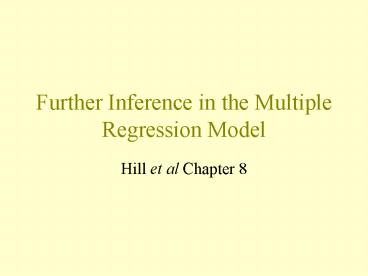Further Inference in the Multiple Regression Model PowerPoint PPT Presentation
1 / 21
Title: Further Inference in the Multiple Regression Model
1
Further Inference in the Multiple Regression Model
- Hill et al Chapter 8
2
The F-Test
Used to test hypotheses on one or more parameters
Unrestricted model
Restricted model
3
The F-statistic
Are the differences in SSE significant?
If the null hypothesis is true, then the
statistic F has an F-distribution with J
numerator degrees of freedom and T-K denominator
degrees of freedom.
4
Example
Fc 4.038
Reject the null hypothesis
5
Testing the significance of a model
Restricted model
6
Example
Fc 3.187
7
An extended model
8
The significance of advertising
Fc3.120
9
The optimal level of advertising
Marginal benefit from advertising
Marginal benefit equals marginal cost
10
Is this significantly different from 40000?
T-test
tc 1.993
11
Is this significantly different from 40000?
F-test
Restricted model obtained by writing the equation
under the assumption that the null is true
Fc3.970
12
Testing two conjectures
- Optimal advertising is 40000
- If advertising is 40000 and price is 2, revenue
will be 175000
Two hypotheses to substitute in to get restricted
model
Fc3.120
13
Incorporating non-sample information
Multiplying each price and income in a demand
equation by a constant ? has no effect on demand
14
A restricted model
15
Omitted and irrelevant variables
- An omitted variable which is correlated with
other variables in the regression will lead to
bias. - The omission of insignificant variables may
lead to bias (remember all you have done is
failed to reject a null) - Including irrelevant variables will inflate the
variances of the estimated parameters.
16
The RESET test principle
- If we omit variables and they are correlated with
existing variables, including a function of these
variables may allow us to pick up some of the
effect of the omitted variables. - If we can artificially improve the model by
including powers of the predictions of the model,
then a better functional form may exist. - Overall if we can improve a model by including
powers of the predictions the model is inadequate.
17
The RESET test practice
In both cases the null is of no mis-specification
18
The RESET test example
The linear model is mis-specified.
19
Collinear Economic Variables
- Explanatory variables move together in systematic
ways. - Attribute the increase in TR that is the
consequence of two types of advertising. - Identify the effects of increasing input
quantities when technology is of the fixed
proportions type.
20
The consequences of collinearity
- Exact collinearity renders OLS inoperable.
- Near exact leads to increased standard errors.
- R2 may be high but individual coefficients are
likely to be insignificant. - Estimates will be sensitive to the addition of a
few observations. - Accurate prediction may still be possible.
21
Identifying and mitigating collinearity
- Identifying
- Large standard errors with high R2.
- Pairwise correlation coefficients in excess of
0.8 - Auxiliary regressions.
- Mitigating
- Additional data.
- Parameter restrictions

